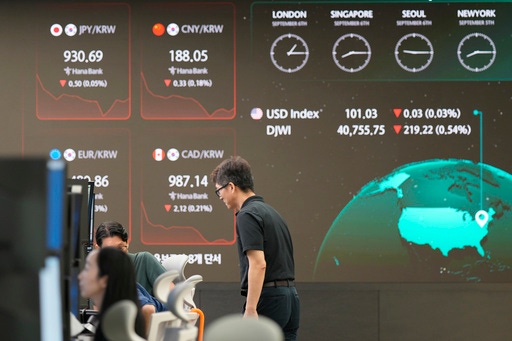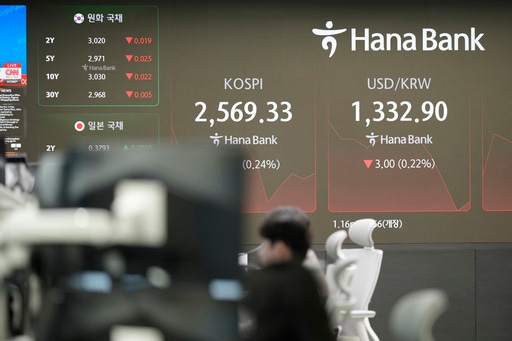Stock market today: Another rout hits Wall Street, as S&P 500 heads for its worst week in 18 months

Currency traders talk near the screens showing the foreign exchange rates at a foreign exchange dealing room in Seoul, South Korea, Friday, Sept. 6, 2024. (AP Photo/Lee Jin-man)[ASSOCIATED PRESS/Lee Jin-man]
NEW YORK (AP) — Another rout is hitting Wall Street on Friday, and technology stocks are taking the brunt of it after a jobs report billed as the most important of the year came in mixed.
The S&P 500 was 1.4% lower in midday trading and heading for its worst week since March 2023. The Dow Jones Industrial Average was down 330 points, or 0.8%, as of 11:15 a.m. Eastern time, after flipping an early gain of 250 points. The Nasdaq composite dropped 2% as Broadcom, Nvidia and other tech companies led the stock market lower.
The action was even wilder in the bond market, where Treasury yields tumbled, recovered and then fell again after the jobs report showed U.S. employers hired fewer workers in August than economists expected. It’s the second straight month where hiring has come in below forecasts, worsening worries after recent data showed weakness in manufacturing and some other areas of the economy.
The weaker-than-expected hiring pushed some traders to up their forecasts for how much the Federal Reserve will have to cut its main interest rate by at its meeting later this month, according to data from CME Group.
Fed Chair Jerome Powell has already indicated it’s likely to cut rates for the first time since the 2020 COVID crash. The Fed wants to protect the job market and keep the economy from sliding into a recession after earlier hiking the federal funds rate to a two-decade high to stifle inflation.
Such cuts can give a boost to investment prices, particularly if the Fed jumps beyond the traditional-sized move of a quarter of a percentage point. But the worry on Wall Street is that the Fed may be moving too little, too late and that the slowing U.S. economy could fall into a recession. That would undercut corporate profits and erase the benefits from lower rates.
“All is not well with the labor market,” said Brian Jacobsen, chief economist at Annex Wealth Management. “The Fed wanted the labor market to come into better balance, but any balancing act is unstable.”
Still, the jobs report did include some more encouraging data points. For one, the unemployment rate improved to 4.2% from 4.3% a month earlier. That was better than economists expected.
And even if August’s hiring was weaker than forecast, it was still better than July’s pace, points out Scott Wren, senior global market strategist at Wells Fargo Investment Institute.
“Do not get hung up on whether” the Fed will cut by either a quarter or by an outsized half of a percentage point on Sept. 18, Wren said. “The important thing is the Fed is beginning a series of rate cuts.”
Christopher Waller, a member of the Fed’s board of governors, said in a speech after the jobs report’s release that “I believe we should be data dependent, but not overreact to any data point, including the latest data.”
“While the labor market has clearly cooled, based on the evidence I see, I do not believe the economy is in a recession or necessarily headed for one soon,” he said.
While Waller said he thinks a “series of reductions” to rates is appropriate given that a slowing job market now looks like the bigger threat for the economy than high inflation, he also said the ultimate pace and depth of those cuts is still to be determined.
All the uncertainty sent Treasury yields on a wild ride in the bond market as traders tried to handicap the Fed’s next moves.
The two-year Treasury yield initially fell as low as 3.64% after the release of the jobs report, before quickly climbing back above 3.76%. It then dropped back to 3.63% following Waller’s comments, down from 3.74% late Thursday.
The 10-year Treasury yield, which moves more with expectations for longer-term economic growth and inflation, slipped to 3.66% from 3.73% late Thursday. It also swung between gains and losses following the jobs report.
On Wall Street, Broadcom tumbled 9% despite reporting profit and revenue for the latest quarter that were above analysts’ forecasts, thanks in large part to the boom around artificial intelligence. The chip company said it expects to make $14 billion in revenue this quarter, which was slightly below analysts’ expectations of $14.11 billion, according to FactSet.
Other chip companies also fell, including a 4.2% drop for Nvidia. After soaring earlier this year as its revenue surged due to the AI frenzy, Nvidia’s stock has been shaky since mid-July as investors question whether they took it too high. That’s even though Nvidia has continued to top analysts’ expectations for growth.
Big Tech companies have grown into the market’s most influential after their superstar runs made them even more massive, and Nvidia was Friday’s single heaviest weight on the S&P 500.
U.S. Steel rose 6.1% after the CEO of rival Cleveland Cliffs told MSNBC that his company would still be interested in acquiring U.S. Steel if the White House were to block its proposed sale to Japan’s Nippon Steel. Lourenco Goncalves also accused Nippon of frequent breaches of trade policies and cited national security issues if the proposed $14 billion Nippon-U.S. Steel were to go through.
In stock markets abroad, indexes fell across much of Europe and Asia. Trading was halted in Hong Kong because of a typhoon.
___
AP Business Writers Yuri Kageyama and Matt Ott contributed.
Copyright 2024 The Associated Press. All rights reserved. This material may not be published, broadcast, rewritten or redistributed without permission.
